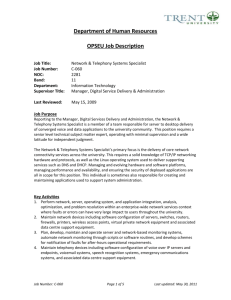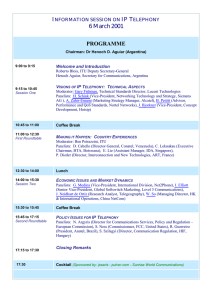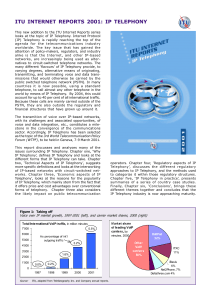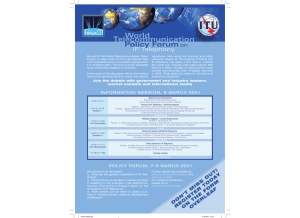IP T W
advertisement
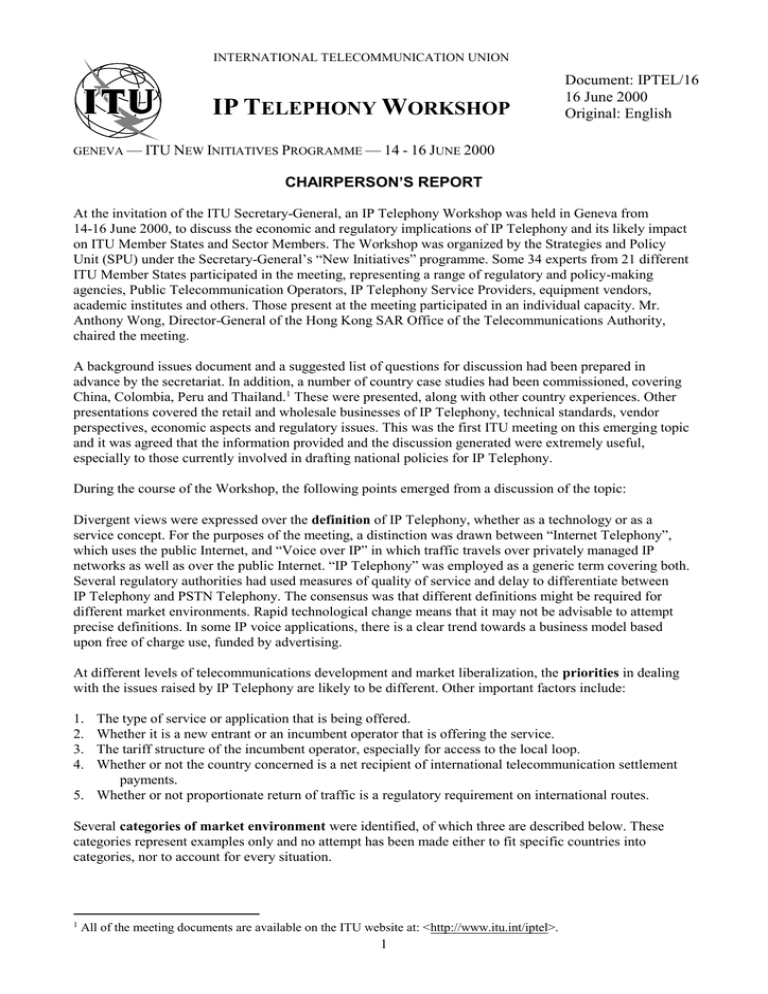
INTERNATIONAL TELECOMMUNICATION UNION IP TELEPHONY WORKSHOP Document: IPTEL/16 16 June 2000 Original: English GENEVA — ITU NEW INITIATIVES PROGRAMME — 14 - 16 JUNE 2000 CHAIRPERSON’S REPORT At the invitation of the ITU Secretary-General, an IP Telephony Workshop was held in Geneva from 14-16 June 2000, to discuss the economic and regulatory implications of IP Telephony and its likely impact on ITU Member States and Sector Members. The Workshop was organized by the Strategies and Policy Unit (SPU) under the Secretary-General’s “New Initiatives” programme. Some 34 experts from 21 different ITU Member States participated in the meeting, representing a range of regulatory and policy-making agencies, Public Telecommunication Operators, IP Telephony Service Providers, equipment vendors, academic institutes and others. Those present at the meeting participated in an individual capacity. Mr. Anthony Wong, Director-General of the Hong Kong SAR Office of the Telecommunications Authority, chaired the meeting. A background issues document and a suggested list of questions for discussion had been prepared in advance by the secretariat. In addition, a number of country case studies had been commissioned, covering China, Colombia, Peru and Thailand.1 These were presented, along with other country experiences. Other presentations covered the retail and wholesale businesses of IP Telephony, technical standards, vendor perspectives, economic aspects and regulatory issues. This was the first ITU meeting on this emerging topic and it was agreed that the information provided and the discussion generated were extremely useful, especially to those currently involved in drafting national policies for IP Telephony. During the course of the Workshop, the following points emerged from a discussion of the topic: Divergent views were expressed over the definition of IP Telephony, whether as a technology or as a service concept. For the purposes of the meeting, a distinction was drawn between “Internet Telephony”, which uses the public Internet, and “Voice over IP” in which traffic travels over privately managed IP networks as well as over the public Internet. “IP Telephony” was employed as a generic term covering both. Several regulatory authorities had used measures of quality of service and delay to differentiate between IP Telephony and PSTN Telephony. The consensus was that different definitions might be required for different market environments. Rapid technological change means that it may not be advisable to attempt precise definitions. In some IP voice applications, there is a clear trend towards a business model based upon free of charge use, funded by advertising. At different levels of telecommunications development and market liberalization, the priorities in dealing with the issues raised by IP Telephony are likely to be different. Other important factors include: 1. 2. 3. 4. The type of service or application that is being offered. Whether it is a new entrant or an incumbent operator that is offering the service. The tariff structure of the incumbent operator, especially for access to the local loop. Whether or not the country concerned is a net recipient of international telecommunication settlement payments. 5. Whether or not proportionate return of traffic is a regulatory requirement on international routes. Several categories of market environment were identified, of which three are described below. These categories represent examples only and no attempt has been made either to fit specific countries into categories, nor to account for every situation. 1 All of the meeting documents are available on the ITU website at: <http://www.itu.int/iptel>. 1 1. In some countries, where long distance and particularly international call tariffs are high, perhaps due to a lack of competition or due to cross subsidies to other services, the major opportunity for IP Telephony Service Providers is for price arbitrage. Users may choose IP Telephony offerings to avoid the high call tariffs levied by incumbent operators. o o o A concern for this group of countries relates to the use of IP Telephony for incoming international calls that bypass the international accounting rate system. The case studies, and some reports from participants, have shown some evidence of a recent reduction in settlement payments due to the use of “compressed” or “packetised voice” on international IP circuits. However, the experience has been that it is very difficult to block incoming international IP telephony calls. The result has been lower net settlement payments, a dilution of the revenues of the incumbent operator and a possible loss of funds for network investment. In some countries, outgoing IP Telephony calls are banned. This precludes consumer benefits from lower-price IP Telephony options and benefits to the operator in the form of cost savings. Evidence from the case studies has suggested that, where IP Telephony has been allowed, the competition introduced has contributed to a substantial reduction in the prices for international and long-distance calls, which in turn has brought about considerable consumer benefits. It is likely that the effect of lowering prices has been to stimulate demand, which will partially offset any possible revenue loss. Further research is required in this area. 2. A second group was identified of countries where call prices are already falling, for instance as part of a transition towards a more liberalised market. The case studies and evidence from other country contributions has shown that a decision not to prohibit IP Telephony in such countries can facilitate the early introduction of a measure of competition to the markets for long distance and international calls, leading to lower prices for consumers. o o o In some of these countries, IP Telephony has been defined in such a way that it can be permitted without impinging upon existing carriers’ licenses and exclusivity periods. For instance, this could be done by defining IP Telephony as a data service or a non-real-time voice service. These regulatory distinctions may not be sustainable in the longer term but may be justified in the interests of extending consumer welfare, in advance of full market liberalisation. The case studies demonstrated the high popularity of low-cost IP Telephony services, and this has the effect of forcing the pace of tariff rebalancing by the incumbent. In several cases, incumbent operators have been encouraged as a result to invest in IP-based networks and to experiment with developing new IP-based services. Until full liberalisation, these regulatory distinctions may lead to anomalies, especially where technology is changing rapidly. 3. A third group was identified of countries where call prices are low, as a result of intense market competition. Here the arbitrage opportunities for IP Telephony services providers are significantly reduced, though IP Telephony may still offer carriers opportunities for cost reduction. o o o o The volume of IP traffic has overtaken voice traffic in a number of these countries. Many carriers are creating or participating in global IP networks that will, in future, carry all of their voice and data traffic over the same network. For consumers in countries where tariffs have already fallen sharply, quality of service and convenience of use are generally more important than in other countries where consumers may be more sensitive to price. The main market opportunity for Voice over IP applications in this group of countries is likely to be in the development of value-added applications, such as unified messaging and voice/web integration. Major issues for this group of countries include those related to interconnection and access, both between service providers and among operators of all types of communication networks. Examples include access to numbering resources, unbundling of local loops, sharing of directory information, offering of leased circuits at wholesale prices and number portability. 2 o Further issues to be considered are the inter-working and convergence between IP-based and circuit-switched networks, especially in view of the fact that it is anticipated that IP will be widely used in third generation (3G) mobile networks. One regulatory question that is being addressed within countries in all market environments is whether or not IP Telephony Service Providers should be required to meet universal service obligations, such as the provision of emergency calls, or to contribute towards universal service funds. The concept of functional equivalence between IP Telephony and PSTN Telephony was discussed as a possible analytical tool in countries which distinguish between reserved and non-reserved voice services. In general, the impact of IP Telephony on public telecommunication operators depends to a high degree on their underlying price structure. Where retail and wholesale tariff structures are cost-oriented, the possible negative impact on revenue is minimal, and incumbent carriers are better placed to exploit the possible opportunities for cost reduction and service innovation offered by IP-based networks. In economies where local calls are metered, a growing share of the local call traffic of public telecommunication operators is now coming from dial-up Internet use. However, the Internet has tended to grow fastest in environments where local call tariffs are unmetered or where local access networks are unbundled. Thus, pricing access to the local loop poses a dilemma for operators seeking to profit from the growth of the Internet as well as for regulators wishing to ensure the sustainability of investment in local access networks. It was recognised that the rapid rate of technological change can easily overtake regulatory classifications. There was widespread support for the concept of technology-neutral regulatory treatment. A consistent approach to regulation may require that similar services be treated in the same way, independent of the underlying network or technology. However, in some environments, regulatory asymmetry will be an inevitable feature of transitional periods. The group noted the important work being undertaken in ITU-T Study Group 2 and the ETSI TIPHON project on allocating an E.164 numbering resource and the IETF ENUM project on interworking between IP networks and the international PSTN. A number reserved for UPT (878) has been designated for the purposes of a trial, which does not interfere with national numbering plans. There was considerable interest in further research on the factors influencing the cost structures of IPbased networks relative to circuit-switched networks. Available studies show divergent results. In some cases, it appears that IP-based networks can be more expensive as a solution for providing telephony. On the other hand, there are potential economies of scale to be gained from offering a unified voice and data network based on IP, bearing in mind the rapid growth of data traffic. In considering IP Telephony, it is important to set it in the context of the wider impact of the Internet on the economy. The Internet diffusion case studies being undertaken by the ITU have shown that the overall impact of the Internet on the economy has been positive. New IP infrastructures can support a variety of innovative services and applications, notably e-commerce. This would be a suitable topic for a future expert meeting. 3

